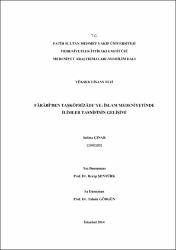| dc.contributor.advisor | Şentürk, Recep | |
| dc.contributor.advisor | Görgün, Tahsin | |
| dc.contributor.author | Çınar, Selime | |
| dc.date.accessioned | 2014-11-14T11:26:38Z | |
| dc.date.available | 2014-11-14T11:26:38Z | |
| dc.date.issued | 2014 | |
| dc.identifier.citation | ÇINAR, Selime, Farabi’den Taşköprizade’ye : İslam Medeniyetinde İlimler Tasnifinin Gelişimi, Fatih Sultan Mehmet Vakıf Üniversitesi Medeniyetler İttifakı Enstitüsü Medeniyet Araştırmaları Anabilim Dalı, Yayımlanmamış Yüksek Lisans Tezi, İstanbul 2014 | en_US |
| dc.identifier.uri | https://hdl.handle.net/11352/2124 | |
| dc.description.abstract | İslam düşüncesinde ilimler tasnifi eserleri, felsefe külliyatının Yunanca ve Süryanice’den Arapça’ya çevrilmesiyle kaleme alınmaya başlanmıştır. Bu eserlerde hem yeni tanışılan ilimler, hem de o zamana kadar oluşmuş İslamî ilimler birbirleriyle ilişkili şekilde ortaya konmuştur. Dolayısıyla tasnifler; ilimlerin tanıtılması, hiyerarşik yapılarının ortaya konması gibi işlevlerinin yanında dar anlamda dînî ilimler-felsefî ilimler ilişkisinin, daha geniş anlamda da din-felsefe ilişkisinin ortaya konduğu eserler olmuştur.
İslam düşüncesinde ilimler tasnifleri iki teoriye dayanmıştır. Bunların birincisi gerçek bilgiyi felsefî bilgi kabul edip dînî ilimleri amelî felsefenin bir dalı olarak gören tasnif teorisidir. Diğeri ise vahyi en üst hakikat kabul eden, peygamberlerden öğrenilen ve onlar etrafında gelişen ilimler ile insan aklıyla ulaşılan, insanlığın ortak mirası olan ilimleri birbirinden ayıran yaklaşımdır. Birincisi filozoflar, ikinci din âlimleri tarafından benimsenmiştir.
Bu tasnifleri birbirinden ayıran en önemli fark hakikat ve hakikate ulaştıran ilim anlayışlarıdır. Varlık hakkında kuşatıcı bilgiye ulaşmayı sağlayan hakiki ilim, felsefî gelenekte tür araştırması yapan, bu şekilde nefsi zorunlu olarak yetkinleştirerek ebedi saadete götüren ilimdir. Dînî gelenekte ise vurgu faydalı ilme yapılmış olup bu, kendisiyle amel edildiğinde ahirette kurtuluşa ve mutluluğa götüren ilimdir. İlk defa Fârâbî’nin düşüncesinde ortaya çıkan hakiki ilim nefsü’l-emr’e göre araştırma yapan; zaman, toplum ve dînîn değişmesine göre değişmeyen ilimdir. Bu kriter dînî tasnif geleneğinde yer alan Taşköprîzâde tarafından felsefî ilimlerin yanında dînî ilimlere da uygulanmış ve iki düşüncenin bir sentezi ortaya konmuştur. | en_US |
| dc.description.abstract | In Islamic thought, literature based on the classification of sciences were written after the translation of philosophical literature to Arabic. In these works both the new philosophical sciences and Islamic sciences were held interrelatedly. In this sense classification of sciences are the works which the sciences are introduced, the hierarchy within the sciences is showed and in the strict sense the relation between religious-philosophical sciences and in the broad sense the relation between religion-philosophy is shown.
Classifications of sciences in Islamic thought are based on two theories. According to one of the theories genuine knowledge is philosophical knowlegde. The other theory considers revelation as the genuine knowledge and separates between the knowledge acquired from prophets and the sciences developed around that and the rational sciences invented by human intellect. First approach is embraced by philosophers and second one is embraced by religious scholars.
The most significant difference between these classifications is their understanding of truth. According to the philosophers, the genuine science which provides apprehensive knowledge about existence is the one that researches things in themselves and that perfects the human soul and leads to eternal bliss. For scholars, the emphasis is on the ones that lead to eternal salvation and happiness if acted accordingly. The genuine science that appears first and foremostly in al-Farabi’s philosophy is the one that researches things in themselves regardless of time, society or religion. This criteria was applied by Tashkopizadah to both the philosophical sciences and the religious sciences thus synthesizing the two theories. | en_US |
| dc.language.iso | eng | en_US |
| dc.publisher | FSM Vakıf Üniversitesi | en_US |
| dc.rights | info:eu-repo/semantics/openAccess | en_US |
| dc.title | Farabi’den Taşköprizade’ye : İslam Medeniyetinde İlimler Tasnifinin Gelişimi | en_US |
| dc.type | masterThesis | en_US |
| dc.relation.publicationcategory | Tez | en_US |
| dc.contributor.institutionauthor | Çınar, Selime | |



















